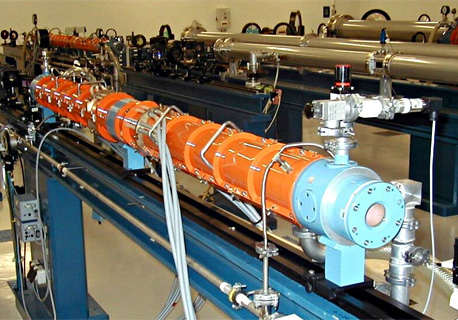|
|
|
Close Help | ||||||||||||||
The present research programme of the Institute comprises particle physics, the physics of condensed matter, plasma physics and optics.
The research in elementary particle physics is carried out mostly within broad international collaborations. We participate in experiments at the large accelerators at CERN near Geneva in Switzerland and at Fermilab in the USA, where the deepest structure of matter and forces governing the microcosm are studied. Closely connected are our activities in the development of particle detectors.
 View inside the ATLAS detector
in the underground experimental hall of the LHC at CERN.
View inside the ATLAS detector
in the underground experimental hall of the LHC at CERN.
The particle physics research involves also astroparticle physics – the field in between particle physics and astrophysics. Cosmic rays of the highest energies are studied within an international collaboration at the Pierre Auger Observatory in Argentina, the world’s largest experimental facility of its kind. Besides, there is engagement in theoretical and mathematical physics and application of particle beams in medicine.

Simulation of a cosmic ray shower induced by a high-energy proton and hitting the detector array of the Pierre Auger Observatory (created by the Cosmus group of the University of Chicago).
The research in the condensed matter physics concerns mainly the dynamic and cooperative phenomena in disordered and inhomogeneous materials. The objects of interest are nanostructured semiconductors, superconductors, liquid crystals, liquid helium, superlattices, grain or domain boundaries, and phase interfaces. Such phenomena as defects and irregularities in the spacial arrangement are investigated in systems with significant dielectric, magnetic, superconducting, superfluid, optical, transport and mechanical properties. Research in the solid state physics is also oriented on growth of thin films and nanostructures, mainly based on silicon, diamond and dilute ferromagnetic semiconductors.
 The texture in
liquid crystal (TGBA phase)
The texture in
liquid crystal (TGBA phase)
New plasma and hybrid technologies are used in the preparation of advanced optical materials for optoelectronics. In the field of quantum optics various types of sources of quantum correlated photon pairs as well as devices for probability copying of quantum states are developed and their characteristics are investigated.

The first power amplifier A1 of the PALS laser
The research in the field of laser-produced plasma is devoted to the dynamics and radiation properties of the dense hot matter created by the terawatt iodine laser system PALS. Fast ions and intense x-ray radiation are used to study the interaction of a focused laser beam with solid and gaseous targets.
Copyright © 2008, Fyzikální ústav AV ČR, v. v. i.